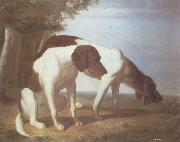Wholesale Oil Painting No Minimum |
|||||||||||
|
|
|||||||||||

|
|||||||||||
|
|
|
||||||||
Jacques-Laurent Agasse1767-1849 Swiss Jacques-Laurent Agasse Galleries (b Geneva, 24 March 1767; d London, 27 Dec 1849). English painter of Swiss birth. Born into a wealthy and politically influential Huguenot family, Agasse spent his early childhood at the country estate of Cravin, where he may have developed the interest in animals and natural history that was to guide his later career as an artist in England. Agasse trained first at the Ecole du Colibri in Geneva and subsequently in Paris under Jacques-Louis David (beginning in 1787) and possibly under Horace Vernet. His early artistic output consisted chiefly of unpretentious silhouette cut-outs in the style of Jean-Daniel Huber. At this time he also undertook a serious study of dissection and veterinary science. |
||||||||
|
|
||||||||
Foxhounds in a Landscape
Foxhounds in a Landscape Painting ID:: 27309 |
oil oil canvas
34 x 41 3/4 in(86.3 x 106 cm) oil oil canvas 34 x 41 3/4 in(86.3 x 106 cm) |
|||||||
|
|
||||||||
|
George Stubbs 1724-1806 George Stubbs Galleries George Stubbs (born in Liverpool on August 25, 1724 ?C died in London July 10, 1806) was a British painter, best known for his paintings of horses. Stubbs was the son of a currier. Information on his life up to age thirty-five is sparse, relying almost entirely on notes made by fellow artist Ozias Humphry towards the end of Stubbs's life. Stubbs was briefly apprenticed to a Lancashire painter and engraver named Hamlet Winstanley, but soon left as he objected to the work of copying to which he was set. Thereafter as an artist he was self-taught. In the 1740s he worked as a portrait painter in the North of England and from about 1745 to 1751 he studied human anatomy at York County Hospital. He had had a passion for anatomy from his childhood, and one of his earliest surviving works is a set of illustrations for a textbook on midwifery which was published in 1751. In 1755 Stubbs visited Italy. Forty years later he told Ozias Humphry that his motive for going to Italy was, "to convince himself that nature was and is always superior to art whether Greek or Roman, and having renewed this conviction he immediately resolved upon returning home". Later in the 1754 he rented a farmhouse in the village of Horkstow,Lincolnshire, and spent 18 months dissecting horses. He moved to London in about 1759 and in 1766 published The anatomy of the Horse. The original drawings are now in the collection of the Royal Academy. Even before his book was published, Stubbs's drawings were seen by leading aristocratic patrons, who recognised that his work was more accurate than that of earlier horse painters such as James Seymour and John Wootton. In 1759 the 3rd Duke of Richmond commissioned three large pictures from him, and his career was soon secure. By 1763 he had produced works for several more dukes and other lords and was able to buy a house in Marylebone, a fashionable part of London, where he lived for the rest of his life. Whistlejacket. National Gallery, London.His most famous work is probably Whistlejacket, a painting of a prancing horse commissioned by the 2nd Marquess of Rockingham, which is now in the National Gallery in London. This and two other paintings carried out for Rockingham break with convention in having plain backgrounds. Throughout the 1760s he produced a wide range of individual and group portraits of horses, sometimes accompanied by hounds. He often painted horses with their grooms, whom he always painted as individuals. Meanwhile he also continued to accept commissions for portraits of people, including some group portraits. From 1761 to 1776 he exhibited at the Society of Artists, but in 1775 he switched his allegiance to the recently founded but already more prestigious Royal Academy. Stubbs also painted more exotic animals including lions, tigers, giraffes, monkeys, and rhinoceroses, which he was able to observe in private menageries. He became preoccupied with the theme of a wild horse threatened by a lion and produced several variations on this theme. These and other works became well known at the time through engravings of Stubbs's work, which appeared in increasing numbers in the 1770s and 1780s. Mares and Foals in a Landscape. 1763-68.Stubbs also painted historical pictures, but these are much less well regarded. From the late 1760s he produced some work on enamel. In the 1770s Josiah Wedgwood developed a new and larger type of enamel panel at Stubbs's request. Also in the 1770s he painted single portraits of dogs for the first time, while also receiving an increasing number of commissions to paint hunts with their packs of hounds. He remained active into his old age. In the 1780s he produced a pastoral series called Haymakers and Reapers, and in the early 1790s he enjoyed the patronage of the Prince of Wales, whom he painted on horseback in 1791. His last project, begun in 1795, was A comparative anatomical exposition of the structure of the human body with that of a tiger and a common fowl, engravings from which appeared between 1804 and 1806. Stubbs's son George Townly Stubbs was an engraver and printmaker. Foxhounds in a Landscape mk127 23x32 |
||||||||
|
|
||||||||
|
Prev Next
|
||||||||
|
|
||||||||
|
Related Paintings to George Stubbs :. |
||||||||
|
|
||||||||
|
CONTACT US |

